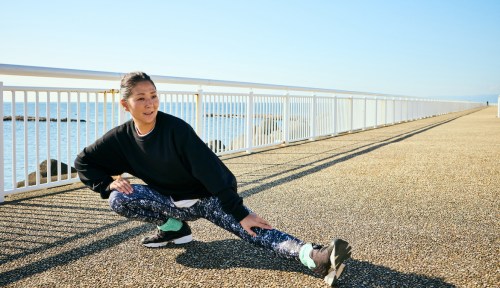Actually, It Turns Out All Those Warnings Not To Stretch Before Working Out Were Wrong
Ever been told not to do static stretching before a workout? Learn why that advice is misguided, and what the science shows.

Holding long stretches used to be considered an integral part of any warm-up before a workout. Think: the toe touches you used to do before soccer practice, or bringing your foot to your butt to stretch your quads before Jazzercise class. But in recent years, this approach, known as static stretching, has gotten a bad rap. As claims that static stretching hurts athletic performance have hit the fitness mainstream, the pendulum has swung towards dynamic-only warm-ups, where you’re continually moving in and out of stretches rather than sitting in them for extended periods.
Experts in This Article
Trainer and physical therapist
However, as tends to happen when the pendulum swings too far in one direction, the general, binary advice of “do not static stretch before exercise” misses out on multiple nuances and details.
“The paradigm shift in recent years from static to dynamic stretching—although rooted partly in research—has missed the mark as further research has given us more details on when static stretching is actually effective and when it isn’t,” says physical therapist Kristina Kam, DPT, of Quantum Performance in California. “It’s not as black and white as ‘don’t do any static stretches prior to activity.’ There are multiple instances when static stretching can really help you, depending on factors such as your specific training program, how long you’re holding it for, and so on.”
Why the avoidance of static stretching is misguided
Yes, there is research showing that static stretching prior to activities can reduce muscle strength, endurance, and possibly performance. However, and this is critical, that effect only takes place during very specific circumstances.
First and foremost, the original research that turned us all off from holding our stretches found that sitting in static stretches for longer than 60 seconds could reduce muscle strength, endurance, and power. But even in these cases, those attributes were only reduced for a few minutes and did not come with any change in gains in strength, endurance, or power from training. Meaning: A workout after static stretching is no less effective; your muscles just might not perform quite as effectively directly afterwards.
Secondly, further research has found that moderate-duration static stretching—around 30 to 45 seconds, in this study—can improve range of motion without eliciting any discernible negative impact on activity or athletic performance. This could be particularly useful if you’re involved in activities like yoga, soccer, or Pilates that require high levels of flexibility.
Also, there’s significant research showing that when static stretching was used as part of a comprehensive routine—particularly when it’s paired with dynamic stretching and sport-specific warm-ups—there was no negative effect on strength or performance.
To sum that all up: Static stretching when done for less than 60 seconds and as part of a comprehensive warm-up routine can improve range of motion while having no negative impact on how well your muscles perform. Nor will it decrease the #gains you get out of your workout.
Are there other things to consider?
The key to static stretching before working out it to take it easy. “You can injure yourself if you’re too aggressive with stretching and for too long—such as with your hamstrings—and if you’re using stretching in the short-term phase after injury, it can actually make the injury worse!” says Dr. Kam. (Think of pulling on a rubber band that is already partially torn, it’s probably a bad idea!)
But with the right approach, static stretching can prep your body to take on bigger movements, and there may also be some positive mental benefits: It can lead to a relaxed state that enhances your level of calmness and potentially even focus—both of which can aid activity. One study found that participants believed they would perform better when stretching was included in their warm-up, and we know that thinking positively and confidently can be half the battle!
“I’ve found that for individuals who already have range of motion problems—whether it’s due to general inflexibility or some physical limitation—static stretching can be helpful as part of the warm-up to give them a mental boost and ease them into activities,” says Dr. Kam.
All in all, it turns out that static stretching before activity is not the bugaboo it’s been deemed to be in recent years. So don’t skip it—just don’t go overboard.
Ready to loosen up? Follow this stretch series before your next workout:
Sign Up for Our Daily Newsletter
Get all the latest in wellness, trends, food, fitness, beauty, and more delivered right to your inbox.
Got it, you've been added to our email list.










